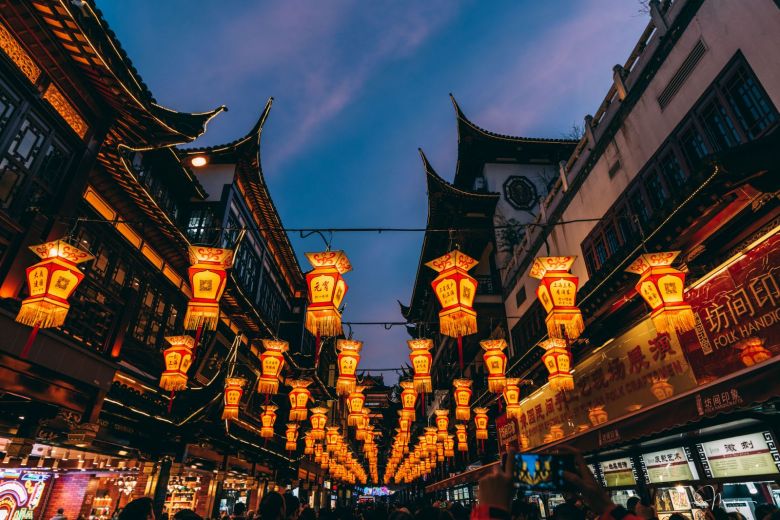Chinese Name: 豫园 Pronunciation: Yù Yuán
Occupied Area: 20,000 square meters
Building Time: Ming Dynasty (1368-1644)
Suggested Visiting Hours: 2 Hours
Address: No. 137, Anren Street, Huangpu District, Shanghai
Best Visiting Season: Spring and Autumn (March to May, September to November)
Opening Hours: 9:00-:16:30, closed on each Monday (Except holidays)
| Tickets | Peak Season (April 1st to June 30th September 1st to November 30th) |
Low Season (July 1st to August 31th December 1st to March 31st) |
| Admission Fee | 40 yuan | 30 yuan |
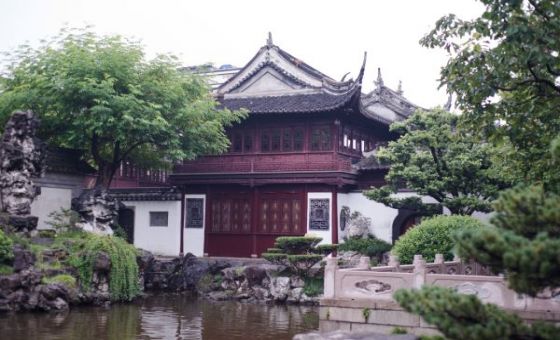
Yu Garden is located in the northeast of the old urban area of Shanghai, by Fu You Road in the north, An Ren Street in the east, and Shanghai Old City God’s Temple in the southwest.
It is the classical garden in the south of Yangtze River. It was built in the Jiajing and Wanli reign of the Ming Dynasty (1368-1644), covering an area of 20,000 square meters.
In the garden, there is the Exquisite Jade Rock, known as one of the most famous stones in the Yangtze River, and Dianchun Hall, the command center of the Xiao Dao Hui (an uprising in 1853). Besides, there are tourist attractions such as Shanghai Old City God’s Temple and the Old Street for shopping.
Yu Garden was opened to the public in 1961 and was listed as a national key cultural relic site by the State Council in 1982.
Yu Garden was originally the private garden in the Ming Dynasty. It was built in the Ming Dynasty and had a history of more than 400 years.
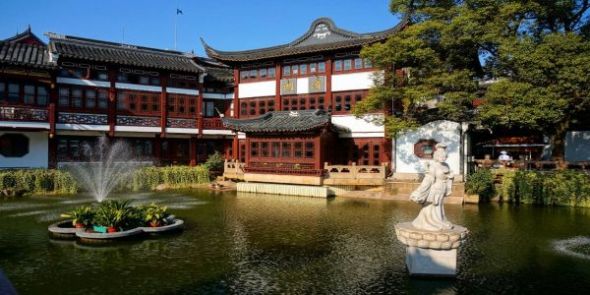
The owner of the garden, Pan Yunduan, a political envoy of Sichuan Province, began to build a garden in 1559 on the fields of vegetable to the west of the house of Pan’s family. After more than twenty years of painstaking efforts, Yu Garden was built.
When Pan Yunduan died in 1601, Pan’s family became weaker and weaker, and they were unable to afford the huge expenditure needed for the renovation and management of the garden. In the late Ming Dynasty, Yu Garden was acquired by Zhang Zhaolin. Late in 1760, in order not to lose charm of this scenic spot, some wealthy local gentry gathered money and bought the Yu Garden. They spent more than 20 years rebuilding the tower and adding more hills and stones.
In 1842, the First Opium War broke out, foreign invaders invaded Shanghai. The British troops occupied Yu Garden and ravaged it.
Since 1956, Yu Garden has undertook a large-scale renovation, and it opened to the public in September 1961.
In 1959, Yu Garden was listed as a municipal cultural relic site under protection.
In February 1982, Yu Garden was declared by the State Council as a national key cultural relic site under state protection.
Rockery is an important element in Chinese classical gardens. It plays a very important role in all ages to decorate every part of the garden.
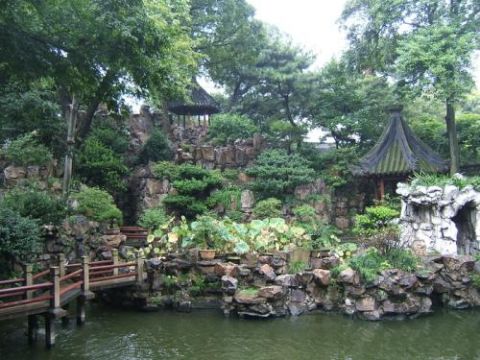
Great Rockery is one of the quintessential sceneries of Yu Garden. It is also the oldest, most exquisite and largest yellow stone rockery in south China. It was elaborately designed and piled by Zhang Nanyang, a famous mountain builder in the Ming Dynasty. This masterpiece is also one of his works in existence. The height of the Great Rockery is about 12 meters. It is very magnificent with 2000 tons of yellow stone in Wukang city, Zhejiang Province. It has been enjoying the reputation of the crown of rockery in south China.
Rockery, as an important part of Chinese gardens, plays its unique function in the separation and organization of the space of the garden. It is independent ornament in the scene and used to protect from the slope. It can reduce the artificial atmosphere and add the natural interest. It has the irreplaceable value in the decoration of the garden.
Cuixiu Hall is located under the northeast cliff. It was built in 1760 and completed in the 35th year of the Qianlong Reign of the Qing Dynasty. In the 18th year of Jiajing(1813), the hall was transferred from Xiyuan Temple to a public area. It is very beautiful with extensive renovation. So, it becomes refined, quiet and clean.
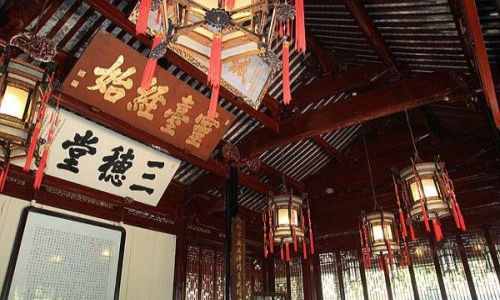
Sansui Hall was originally named as “Leshou Hall”(Happiness and Longevity Hall). In the 25th year of the Qianlong reign of the Qing dynasty, Sansui Hall was built on the old site of Leshou Hall. In the late Qing Dynasty, the establishment of the standard dendrobium for rice and beans in Sansui Hall was called “Jiao Hu Hall”. Therefore, the corn, sorghum fruits and so on were engraved on the board on the front door.
Sansui Hall is the highest hall of Yu Garden with its very peculiar building. In the Qing Dynasty, it was also the place where local gentlemen gathered. The central hall is hung with the writings of Pan Yunduan . Above it, there are three inscribed board “Sansui Hall”, “Lingtai Jinghshi Hall” and “Chengshi Shanlin Hall”.
There is an ancient story about the name “Sansui Hall”. In the late Han Dynasty, there was a man called Cai Maosheng. Before he became prosperous, one day, he had a dream that there are three Sui( ear of the grain) in one grain. He stretched out his hand to get the middle one. After he woke up, his housekeeper explained that it was an auspicious symbol. As expected, he did take a position in the royal court.
This allusion expresses the expectation of a good future. The words “Sansui” also means a pray for harvest.
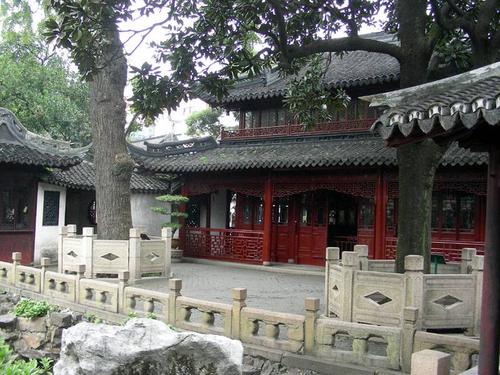
There are two ancient trees in the front court of Wanhua Chamber. One is ginkgo tree more than 430 years old, the other is magnolia grandiflora for more than 100 years old. It is also a relatively crowded place for visitors.
Wanhua Chamber was formerly known as “the Flower God Pavilion”. According to the legend, the owner of the garden, Pan Yunduan’s grandson had a daughter, named Yujuan. She was 16 years old with kindness and beauty. She loved flower very much and often planted some flowers. Later she fell in love with the gardener Guo Tiansheng. But the gardener died. The girl was so grieved that she couldn't eat or sleep, and soon she died of grief.
Suddenly one day, a colorful auspicious cloud showed up in the sky, and the girl Yujuan and the boy Guo Tiansheng appeared. The girl carried the basket filled with varied flowers. She scattered the beautiful flowers to the earth. The people were very surprised, called Yujuan as “The God of Flower” and built this place as “the Flower God Pavilion”.
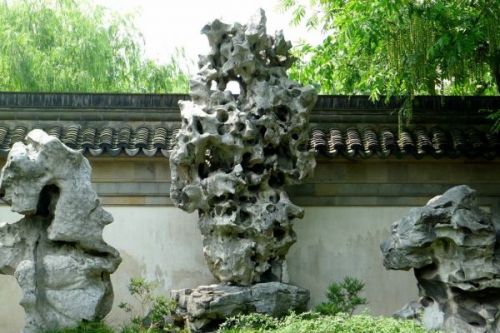
There is a treasure which is called “Exquisite Jade Rock ” in the Yu Garden. It is also known as the three great peaks in the south of The Yangtze River, which together with Guangyun Peak in Suzhou and Zouyun Peak in Hangzhou. This rock is about 3 meters high, 1.5 meters wide, 80 centimeters thick, and weighs about 3 tons. It has the wrinkle, leak, thinness and beauty of the stone of the Taihu Lake.
In the Ming Dynasty, it was reported that this beautiful stone was placed in a private garden of an official, Chuyu in Jiangxi Province. Then, Chu’s daughter married Pan Yunliang’s(the builder of the Yu Garden) brother. When Pan’s family built the Yu Garden, they moved this rock to their garden.
According to legend, when the ship was crossing the Huangpu River, there was a horrible wind and the stones all sank. Pan thought this was not a good omen. They tried their best to salvage the rock. Surprisingly, they picked up another stone. It was strange that the two stones connected with each other perfectly. So, the Exquisite Jade Rock was formed.
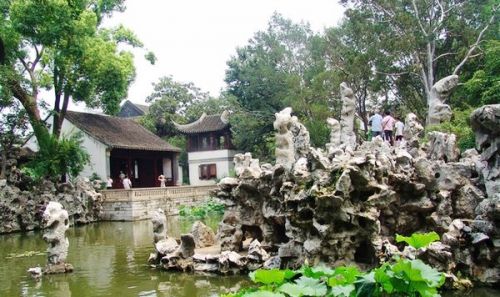
In front of the “Getting Better” veranda, there are iron lions of the Yuan Dynasty. On the left side, there is a female lion and on the right side, there is a male lion. They were cast in 1290. On the base there is a note: “The artisan Zhao Zhang in Tong Shan Town of Zhang De Fu An Yang County.”
The iron lions have vivid posture and exquisite casting. The lion in the east with a big mouth and bright eyes is very strong and smart. The lion in the west is very docile and cute, playing with the little lion with her front claw.
The lions are beautiful in shape, clear in texture and exquisite in casting. They are very popular with tourists. Both Chinese and foreign tourists come here to touch the lions. Now the skin of the lions becomes very smooth because they are touched by so many people.
The two lions were cast by Zhao Zhang, a craftsman from Tongshan Town, Anyang County, Henan province.
During the Anti-Japanese War, it was looted and taken to Tokyo, Japan, where it was nearly melted down to make guns. After the discovery of the iron lion on the base of the soldering number, it was identified that this is a national treasure of China. So, it was protected from extinction. After the victory of the War of Resistance against Japanese Aggression, the iron lions were returned to China, but it was kept in the warehouse for a long time.
It was relocated when the Yu Garden was being repaired at the end of last century, which added an ancient point of view to the Yu Garden in Shanghai.
The Yu Garden main gate→ Jiang Zeming’s(Former chair) inscription → Sansui Hall→ Yangshan Hall→ Iron lions→ Suixiu Hall→Great Rockery→ Ginkgo tree→ Wanhua Chamber→ Dianchun Hall→ Hexu Hall→ Laojun Temple→ Huijing Tower→ Nine Lion Study→ Sanqu Bridge→ Yuhua Hall→ Exquisite Jade Rock→West Gate.
Take bus No 11, 24, 736, 930, 980 and get off at Xinbeimen Station, and then walk along Anren Street about 2 minutes to get to the Yu Garden.
Take Metro Line 10 and get off at Yu Garden Station.
Chinese: 请带我去豫园。English: Please take me to Yu Garden.
If you go to the Yu Garden from the center of Shanghai, it takes about 18 minutes (21 yuan).
If you go to the Yu Garden from the Shanghai Train Station, it takes about 24 minutes (32 yuan).
If you go to the Yu Garden from the Shanghai Hongqiao International Airport, it takes about 41 minutes (62 yuan).
